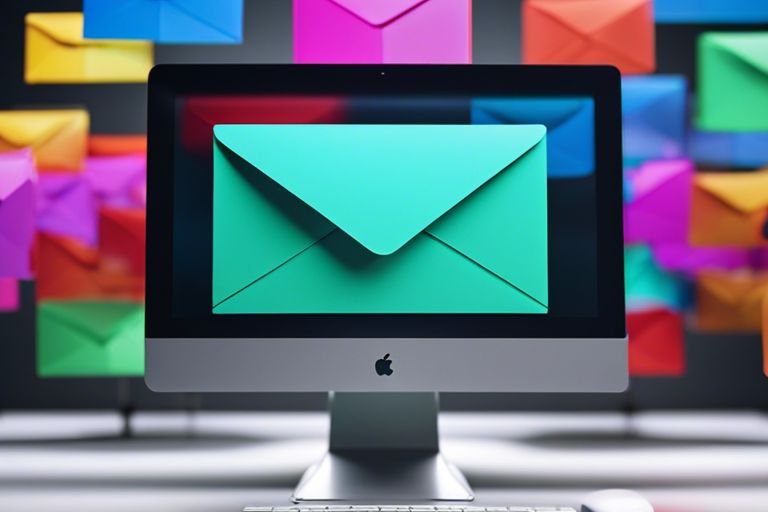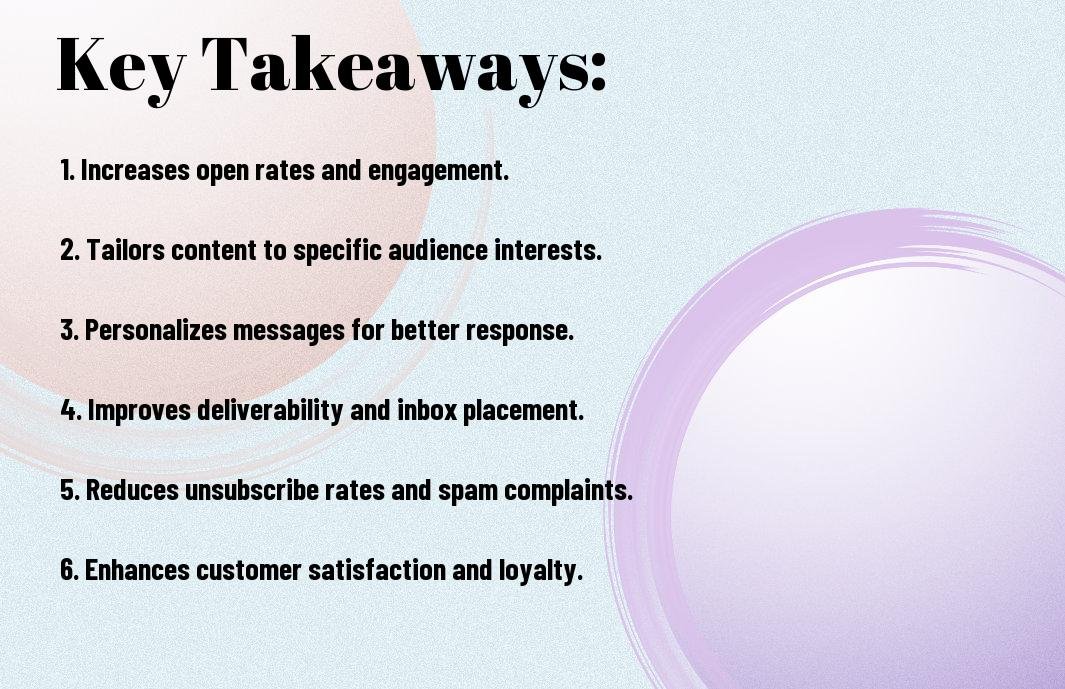Just sending out mass emails to your entire subscriber list is no longer enough to drive successful email marketing campaigns. Email list segmentation is the practice of dividing your email subscribers into smaller segments based on specific criteria such as demographics, behavior, or preferences. This targeted approach allows you to personalize your messages and tailor them to the unique needs and interests of each segment. By segmenting your email list, you can improve engagement, increase open and click-through rates, reduce unsubscribes, and ultimately boost your conversion rates. Understanding the importance of email list segmentation and implementing it effectively can make a significant difference in the success of your email marketing efforts.

Key Takeaways:
- Email list segmentation is the practice of dividing your email subscribers into smaller groups based on specific criteria such as demographics, behavior, or preferences.
- Segmentation allows you to send highly targeted and personalized content to different groups of subscribers, increasing the relevance and effectiveness of your email campaigns.
- By segmenting your email list, you can improve open rates, click-through rates, and ultimately, conversion rates, as you are delivering more tailored content to your subscribers.
- Segmentation can help reduce unsubscribes and spam complaints by ensuring that subscribers only receive content that is relevant and valuable to them.
- Regularly analyzing and adjusting your segments based on subscriber behavior and engagement can help you refine your email marketing strategy and drive better results over time.


The Basics of Email List Segmentation
Definition of Email List Segmentation
Now, let’s probe into the fundamental concept of email list segmentation. Email list segmentation is the practice of dividing your email subscribers into smaller groups based on specific criteria. By organizing your email list into segments, you can tailor your email marketing campaigns to target different customer segments with personalized content and offers.
Different Methods of Segmenting Your Email List
Any successful email marketing strategy relies heavily on proper segmentation of your email list. There are various methods you can use to segment your email list, such as demographics, psychographics, past purchase behavior, engagement level, and more. By using these segmentation methods effectively, you can deliver targeted emails that resonate with your subscribers and drive higher engagement and conversions.
One key method of email list segmentation is demographics, where you divide your subscribers based on factors like age, gender, location, or income level. Another crucial method is behavioral segmentation, which involves categorizing subscribers based on their interactions with your emails and website. By leveraging these segmentation methods, you can create highly personalized and relevant email campaigns that cater to the specific needs and preferences of your audience.
The Importance of Email List Segmentation
Once again, email list segmentation proves to be a fundamental strategy for any successful email marketing campaign. According to Email segmentation: Why it matters + 13 strategies, segmenting your email list allows you to tailor your messages based on specific criteria, leading to higher engagement rates and better overall campaign performance.
Improved Email Engagement
Any successful email marketing campaign relies on high engagement rates to drive conversions. With email list segmentation, you can create personalized content that resonates with different segments of your audience. By sending relevant content to specific groups, you are more likely to capture their attention and encourage them to take action.
Enhanced Campaign Relevance
An effective way to ensure your email campaigns are relevant to your audience is through segmentation. By dividing your email list into smaller, targeted groups, you can tailor your campaigns to suit the specific needs and preferences of each segment. This level of personalization not only increases the relevance of your emails but also helps build stronger connections with your subscribers.
Email list segmentation enables you to send tailored messages to your audience, increasing engagement rates and ultimately leading to higher conversions. By delivering content that is relevant to each segment of your email list, you can maximize the impact of your campaigns and build stronger relationships with your subscribers.

Implementing Email List Segmentation
Data Collection and Analysis
Many successful email marketing campaigns rely on the power of email list segmentation. Email segmentation involves categorizing your subscribers into different groups based on various factors such as demographics, purchase history, and engagement with your emails. To implement effective segmentation, it is crucial to first collect relevant data about your subscribers and analyze it to identify patterns and preferences.
Techniques for Effective Segmentation
Segmentation techniques play a vital role in improving the relevance and success of your email marketing efforts. By using advanced segmentation techniques, you can target specific groups of subscribers with personalized content that resonates with their interests and needs. Techniques such as behavioral segmentation, demographic segmentation, and psychographic segmentation can help you create more targeted and impactful email campaigns.
Techniques
By utilizing segmentation techniques effectively, you can increase your email open rates, click-through rates, and ultimately, your conversion rates. Segmenting your email list allows you to send more relevant content to your subscribers, leading to higher engagement and loyalty. It also helps you avoid sending irrelevant emails that could result in unsubscribes or spam complaints.
Challenges and Best Practices
Common Obstacles in Email List Segmentation
Practices In the process of email list segmentation, marketers often face common obstacles that can hinder the success of their campaigns. These obstacles include inadequate data, lack of proper segmentation tools, and limited understanding of the target audience. Without overcoming these challenges, marketers may struggle to create targeted and personalized email content.
Best Practices for Successful Segmentation
List Segmentation is crucial for effective email marketing, and there are several best practices to ensure successful segmentation. It is crucial to regularly update and clean your email list to maintain accuracy. Utilize analytics and data segmentation tools to gather insights about your subscribers and create relevant segments. Personalize your email content based on subscriber behavior and preferences to increase engagement and conversions.
Email list segmentation best practices involve not only dividing your subscribers into segments but also continuously analyzing and optimizing your segmentation strategy. By testing different segmentation criteria and monitoring the performance of your segmented campaigns, you can refine your approach and maximize the impact of your email marketing efforts.
Final Words
Taking this into account, email list segmentation is a crucial strategy for maximizing the effectiveness of your email marketing campaigns. By dividing your subscribers into targeted segments based on their preferences, behaviors, and characteristics, you can deliver more personalized and relevant content that resonates with each group. This not only improves engagement and conversion rates but also helps to build stronger relationships with your audience. Ultimately, email list segmentation allows you to tailor your messages to the specific needs and interests of different segments, increasing the likelihood of success and driving better results for your business. So, make sure to invest the time and effort into segmenting your email list properly to unlock its full potential and take your email marketing to the next level.
FAQ
Q: What is email list segmentation?
A: Email list segmentation is the process of dividing your email subscribers into smaller groups based on specific criteria such as demographics, behaviors, purchase history, or engagement level.
Q: Why is email list segmentation crucial?
A: Email list segmentation is crucial because it allows you to send targeted and personalized content to different segments of your audience, increasing the relevance of your emails and improving engagement and conversion rates.
Q: What are the benefits of email list segmentation?
A: Some benefits of email list segmentation include higher open and click-through rates, reduced unsubscribe rates, improved deliverability, increased revenue, and better customer relationships.
Q: How can I segment my email list effectively?
A: To segment your email list effectively, first identify the criteria that are most relevant to your business goals. Then, use an email marketing platform to create segments based on these criteria and tailor your email content to each segment.
Q: What are some common segmentation criteria?
A: Some common segmentation criteria include demographics (age, gender, location), psychographics (interests, behaviors), purchase history, engagement level (active, inactive), and lifecycle stage (new leads, repeat customers).
Recent Posts
Affiliate Offer Goldmine: How I Find Profitable Affiliate Offers
Affiliate marketing can be overwhelming if you rely on guesswork or follow generic advice. I've discovered that most beginners waste time promoting overcrowded, untested, or unprofitable offers. In...
As an affiliate marketer, you know how crucial it is to create engaging and effective blog posts that drive traffic and generate sales. But coming up with fresh and profitable ideas can be a...

